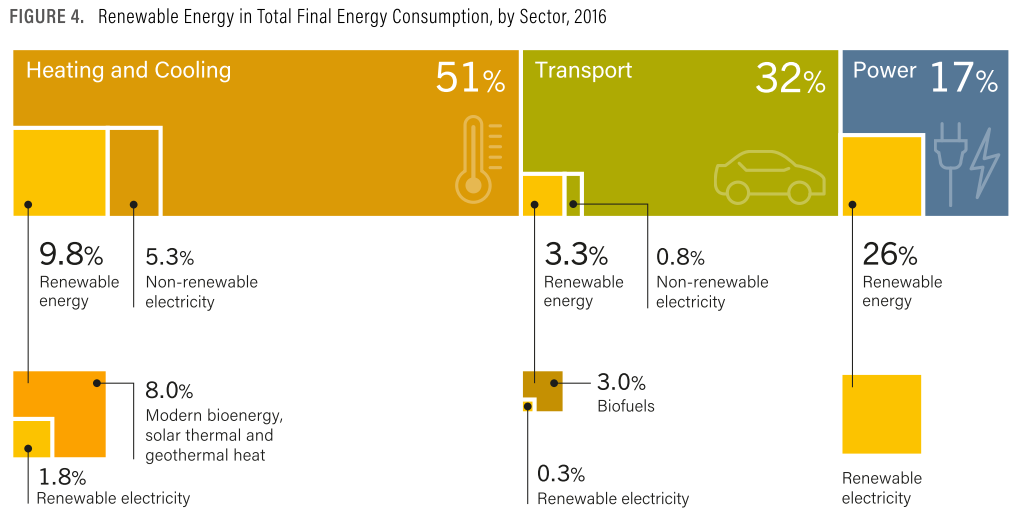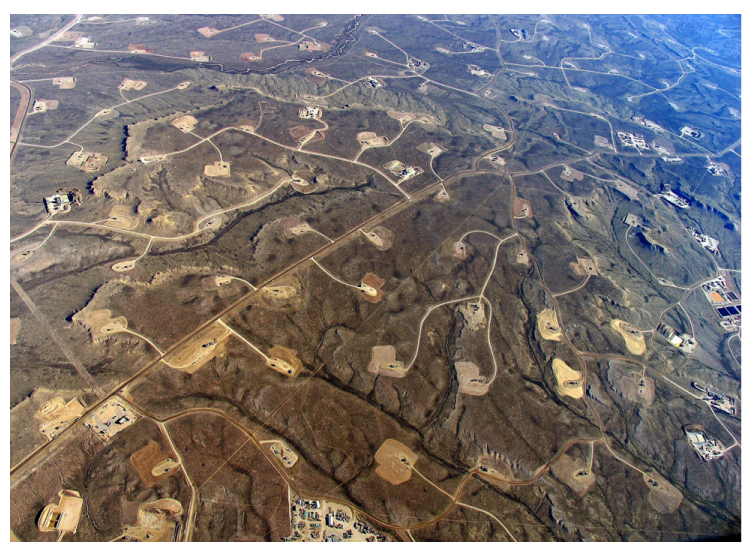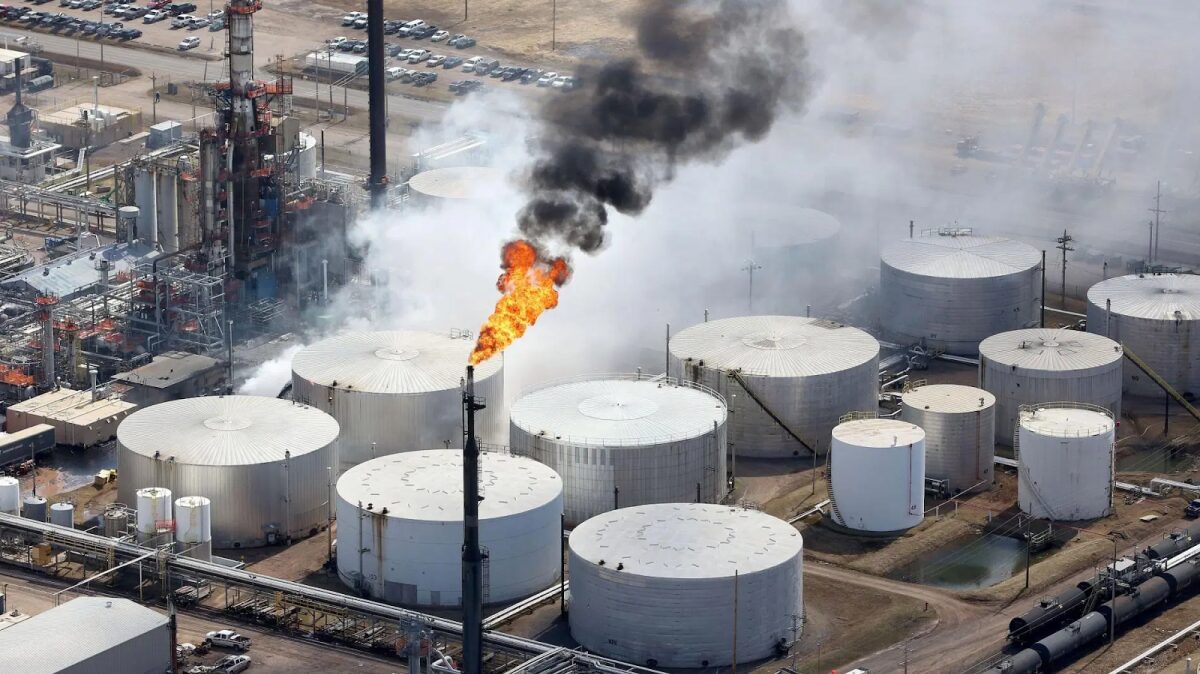Ich wage zu behaupten, dass es in der Leserschaft nur wenige gibt, die sich für das verbürgen würden, was einige als 'saubere' Kohle (keine Sorge, ich werde nicht (Zitat: "Der beliebteste Possenreißer des Präsidenten, der heutzutage genug Aufmerksamkeit bekommt").
In vielen Ländern wird die Kohle als vorherrschende Energiequelle schrittweise abgeschafft. Strom Produktion (die derzeit weltweit ~40% ausmacht) zu Gunsten von 'sauberes' Erdgas (~23%) und erneuerbare Energien (~7%), was vor allem auf die rasch sinkenden Preise für beide Energieträger und eine strengere Klimapolitik zurückzuführen ist (viele EU-Länder, Japanund die Liste geht weiter...). Das Problem ist, dass in dieser Länderliste die beiden großen Länder - China und die USA - fehlen.
Wenn man über die Energiewende nachdenkt, ist es jedoch wichtig, nicht nur an die Elektrizität zu denken (nur 17% der globalen Endenergie), sondern auch an Heizung und Kühlung, die für mehr als die Hälfte des heutigen weltweiten Endenergieverbrauchs (Abb. 1). Während für die Kühlung hauptsächlich Strom verwendet wird, sind über 80% des europäischen Wärmebedarfs wird immer noch mit fossilen Brennstoffen gedeckt (Öl, Gas, Kohle). Die Diskussion über die Dekarbonisierung unserer (stationären) Energiewirtschaft erfordert eine Planung für die Umwandlung des Strom- und des Wärmesektors, die durch die Elektrifizierung mit erneuerbaren Energien unweigerlich gekoppelt werden.

Globaler Anteil erneuerbarer Energien am gesamten Endenergieverbrauch nach Sektoren (2016). Angepasst von der REN21-Bericht 2019.
Beide Sektoren sind reif für eine systematische Dekarbonisierung, aber sollte Erdgas in diesem Prozess eine Rolle spielen?
Wenn Sie jemand sind, der die IPCC-Ziele als entscheidend für unsere Erde betrachtet, Die Erdgasoption ist nicht gut genug, um den unumkehrbaren Klimawandel zu verhindern.die eine andere Entscheidung erfordern: dekarbonisierte erneuerbare Energie. Dieser Artikel zeigt auf, warum wir die "Brücke" bereits überquert haben, was einen Ausstieg aus dem Erdgas und eine weitgehende Abkehr davon erforderlich macht, und bietet einen lösungsorientierten Ansatz für eine Debatte, die für unseren Planeten moralisch verpflichtend ist.
Gehen wir die Liste durch und entlarven wir die häufigsten Aussagen, die man in der Echo-Kammer der Benzinfresser" hört
"Der Umstieg auf Erdgas steht im Einklang mit den fortschrittlichen Klimazielen".
Es gibt ein weit verbreitetes Argument, dass Kohle zu Gas (Strom)oder Öl zu Gas (Heizung) Vermittlung bietet eine Möglichkeit, eine zuverlässige Energie-"Brücke" zu schaffen, bis die erneuerbaren Energien "bereit" sind, und gleichzeitig die Klimaziele zu erreichen. Schließlich hat Erdgas fast die Hälfte der Emissionen von Kohle und 27% weniger als Ölund ist aufgrund der jüngsten Fortschritte bei unkonventionellem Schiefergas (z. B. Fracking) viel billiger als beides.). Sogar Umweltschützer und Klimaaktivisten haben es gesagt.
Das Argument im obigen Absatz ist sowohl falsch als auch verhängnisvoll, da die vorgelegten Zahlen nicht die vollen Auswirkungen von Erdgas berücksichtigen. Vom IPCC: "Die Verbesserung der Energieeffizienz fossiler Kraftwerke und/oder die Umstellung von Kohle auf Gas werden allein nicht ausreichen, um dieses Ziel [Netto-Null bis 2050] zu erreichen.

Suchen Sie ein Timesharing? Dann ist dieses Öl- und Gasfeld in Wyoming, USA, genau das Richtige für Sie. Bild abgerufen von ScienceLine.
"Es ist klar, dass die Umstellung auf einen unverminderten Verbrauch fossiler Brennstoffe allein nicht ausreicht, keine langfristige Antwort auf den Klimawandel bietetaber dennoch kann es sein, dass significant CO2 and air quality benefits, in specific countries, sectors and timeframes, from using less emissions-intensive fuels.”
It’s apparent from the above statements that our world’s biggest governments and institutions are avoiding the obvious fact that we need to de-fossilize in order to de-carbonize.
So why aren’t the fossils declining as fast as climate targets demand it? For coal, it’s not exactly news that the coal industry is in decline in the US und Europa, mostly due to non-competitiveness with natural gas and renewables as well as climate regulations, but globally coal is still on the rise in Asia, South America, and Africa. Hand in hand, heavy regulations on oil and its use sectors for heat generation are being felt — already new buildings in California, Switzerland, Deutschland, etc. are effectively not allowed to have oil boilers (in Switzerland this is a murky cantonal law, but sets very high standards for buildings that oil boilers likely cannot meet). In the Netherlands, even new gas connections aren’t allowed. Unfortunately, natural gas demand is rising rapidly, year over year, mainly driven by the US and Russia.
“Natural gas will only serve as a ‘bridge’ in the meantime”
Even though the EU climate plans point to phasing-out unabated (no carbon capture) natural gas by 2050 (in order to achieve Net Zero emissions), most draft National Energy and Climate Plans (NECPs) are inconsistent with the 1.5 trajectory, planning to expand natural gas infrastructure thus locking-in these investments well past 2050.
The US, even though it is still technically in the Paris Accords, with its fervor for “frack, baby, frack” has just set its record for natural gas use in the power sector. Even in the good old Obama days, energy and climate regulations have long supported (led by Energy Secretary Ernie Moniz) the exploitation of cheap and abundant natural gas sources and expansion of LNG infrastructure.
This represents a stranded asset threat to all power plant investments today. Typically these plants last 25-50 years, a timespan that does not line up with the IPCC 2050 goals. Furthermore, natural gas use has significant infrastructure dependencies, necessitating extensive networks of pipelines, compression stations, and extraction facilities. A similar story exists for heating technologies on the building-level, with gas boilers having lifetimes of 15-30 years, also not lining up with our climate goals.
The European NECPs are due at the end of 2019. On the bright side, there is one example of a country ahead of the curve — the Netherlands. The Dutch are phasing out natural gas by 2030 with plans to shut the well of its infamous Groningen gas field (earthquakes have damaged tens of thousands of homes) and will progressively disconnect the 88% of Dutch homes that have a gas connection.
“Natural gas is the cleaner fuel between coal & oil for both human health and climate”
Millions of people die every year from air pollution attributed to coal electricity production. Agreed, we must switch to cleaner fuels, and it is true that natural gas combustion has much lower figures than coal for particulate matter, NOx, and SOx, but by no means is it ‘healthy’ for the people living nearby. In fact, it is a slight-of-hand trick to only look at the post-combustion figures.
Many have indulged in this dangerous trick of not taking into account air, water, land-use, and seismic impacts of natural gas infrastructure, especially with the emergence of fracking (hydraulic fracturing, which many countries have banned). If we priced such externalities, I doubt that natural gas would be so cheap.
What truly debunks the air pollution and climate ‘benefits’ of natural gas are recent findings that methane leakage emissions of infrastructure are much higher than previously thought and even actually above coal. Remember: methane (CH4) has 30 times the global-warming potential (GWP) of CO2 over a 100 year time horizon, and has its highest impacts in its first 20 years in the atmosphere where it has a GWP over 80 times that of CO2.
Natural gas is definitely not good for human health, and has dubious benefits to the climate.
“Natural gas is the most cost-competitive electricity generation technology and is needed for grid reliability”
We have seen direct ‘1-to-1’ coal-to-gas switching for economic and efficiency reasons in the US and Europe. These plants can fire up whenever needed, which for old-school electrical engineers would be considered necessary to balance a grid dominated by intermittent renewables. Luckily, these days we have optimization and smart-grid capabilities to move forward. To solve this, we need to think outside the box of the typical centralized grid as it transforms towards a flexible system typified by decentralized renewables.
To put it simply, many countries are planning to meet their climate goals with (1) huge leaps in energy efficiency (also called ‘non-wires alternatives’) and (2) rapid installation of renewables. One main advantage of this transition is that an entirely electrified energy system allows over 40% reduction in energy use, mostly due to the lack of combustion in the mix.
Both drivers are already causing natural gas power plants — peakers and Combined Cycle — to be pushed out of the market in the US. This is quite breaking news: just in 2019, the Rocky Mountain Institute showed that Clean Energy Portfolios (combinations of wind, solar, and battery storage, and non-wires alternatives) have become cheaper for utilities than 90% of planned natural gas power plants. But don’t take RMI’s word for it — recently a utility in the US state of Oregon came to the same conclusion.
Even Lazard, the global de-facto standard in electricity generation prices, has stated the following about the cost-competitiveness of renewables:
“We find that Alternative Energy technologies are complementary to conventional generation technologies, and believe that their use will be increasingly prevalent for a variety of reasons…”
This is without considering the role of direct energy subsidies to the renewables. Although, subsidies to the fossil-fuel industry are not commonly discussed and are much greater than for clean technologies. In 2015 the IMF estimated that this was worth a whopping $5.2 trillion – mainly to coal, petroleum, and natural gas. It is impressive to see that the comparably little subsidies for the clean solutions previously mentioned are already cost-competitive in some places, and will only continue to out-perform the dinosaurs.

One vision of the global energy roadmap towards 100% Wind, Water, Solar. Image from Jacobson, et al. (2017).
Decarbonized renewable energy sources are reliable, cost-competitive, and ready
The solutions to jump past the natural gas ‘bridge’ are there, now we must drive them forward.
For electricity: wind, solar, and batteries along with other renewable sources and storage (maybe even Hydrogen).
For heating: general electrification through heat pumps for deeply renovated individual buildings, and district heating networks are already cost-competitive and can supply reliably. Some European countries have shares of district heating in the range of 10-25% and researchers have said that could increase to 50% in heating decarbonization scenarios.
There is no other way around it — natural gas does and should not fit into the climate-compatible nor cost-effective energy system of tomorrow . Any of the common arguments presented above are simply a way for incumbent fossil-fuel owners and investors to justify their continued ‘safe bets’ in infrastructure. The other main point I missed — jobs — has been shown in a 100% renewables world to be a net gain in the range of twenty million jobs by 2050.
Running away from coal and oil is not enough. We need to decarbonize now and fast and kick out natural gas in the upcoming energy regulations. This means 100% renewable energy by 2050 (Fig. 3). That starts with having 80% by 2030. It’s time to act tough on natural gas.
Thank you to all of the editors who contributed to the post! Front cover photo retrieved from Quartz.
If you are part of ETH Zurich, we invite you to contribute with your findings and your opinions to make this space a dynamic and relevant outlet for energy insights and debates. Find out how you can contribute and contact the editorial team here to pitch an article idea!




Great contribution, Evan!
Fully agree: we are often focusing too much on coal and oil, forgetting that new investments in gas will not lead to a green future either.
Fully agree!
Even though district heating as of today is also not sustainable. Main sources are combustion/CHP and other waste heat, which we shouldn’t rely on and work on reducing substantially. With the rise of BECCS, those high temperature district heating networks (130C) could be interesting again.
[…] many as 30 years. The problem with such stranded assets has been discussed in detail in an earlier article on this […]
Yes, natural gas is a bridge to the 3 celsius world, that‘s for sure.
But I doubt that the solution is a combination of decentralized renewables, batteries and hydrogen storage. Why? Because this is no mature and scalable technology.
For Europe a solution exists: build a supergrid which connects the best renewable resources in Europe. These resorces are the combined wind potentials of north scandinavia, north atlantic/north sea and balcan. Because these regions have independent wind regimes.
“Decarbonized Renewable Energy”…I see what you did there. Why does this post leave out the environmental impacts of creation of storage vessels and other “renewable” capture sources?